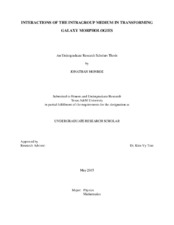| dc.creator | Monroe, Jonathan T | |
| dc.date.accessioned | 2017-10-10T20:27:08Z | |
| dc.date.available | 2017-10-10T20:27:08Z | |
| dc.date.created | 2015-05 | |
| dc.date.issued | 2014-09-20 | |
| dc.date.submitted | May 2015 | |
| dc.identifier.uri | https://hdl.handle.net/1969.1/164471 | |
| dc.description.abstract | We utilize high resolution data from Hubble Space Telescope (HST) to study the role of the group environment in galaxy evolution. The majority of galaxies in the universe fall into this regime, and thus are of paramount importance in our understanding of the general evolutionary structure of galaxies. Much work has gone into observing and classifying the effect of the cluster environment on a galaxy’s characteristics, but the question remains what role progenitors to this environment (namely groups) play in this change. We conclude that the particular subject of our study has well replicated the effects of the cluster environment. It has uniform characteristics which, while not as dramatic with the cluster regime, are nonetheless consistent with the expected observations of clusters. | en |
| dc.format.mimetype | application/pdf | |
| dc.subject | extragalactic astronomy, astronomy, group, cluster, supergroup, hubble space telescope, galaxy | en |
| dc.title | INTERACTIONS OF THE INTRAGROUP MEDIUM IN DEFORMING GALAXY MORPHOLOGIES | en |
| dc.type | Thesis | en |
| thesis.degree.department | Physics and Astronomy | en |
| thesis.degree.discipline | Physics | en |
| thesis.degree.grantor | Undergraduate Research Scholars Program | en |
| dc.contributor.committeeMember | Tran, Kim-Vy | |
| dc.type.material | text | en |
| dc.date.updated | 2017-10-10T20:27:08Z | |


